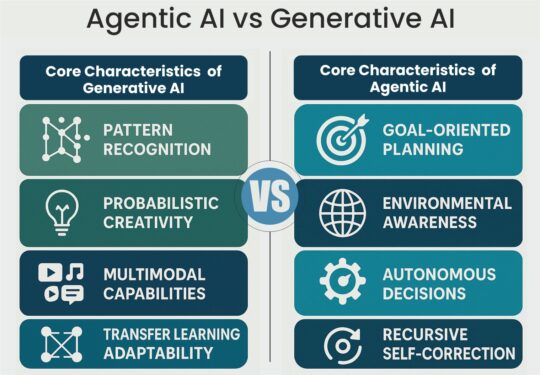In the past, computers simply obeyed our directions. But these days, we see the emergence of AI systems that can independently solve complicated issues and produce content. The leap from reactive technologies to these new proactive ones represents one of the most fascinating shifts in computing history.
Some of these systems excel at producing fresh, imaginative content from scratch. Like they can transform simple prompts into sonnets, symphonies, or realistic images. Others autonomously navigate tasks with independence, making decisions and adjusting course as circumstances change.
We shall discover the various capabilities of Agentic AI vs Generative AI in this blog, but we will also be aware of their limitations.
Agentic AI: The Decision-Making Pathfinder
Agentic incorporates reasoning modules, planning frameworks, and feedback mechanisms that enable them to determine not just what to do but how to do it. One can think of them as colleagues rather than tools who are capable of breaking down complex tasks into actionable steps and adapting when confronted with unexpected obstacles.
Generative AI: A Powerhouse of Creativity
Generative AI technologies use complex neural networks, particularly transformers and diffusion models, to learn patterns from massive datasets and then produce entirely new content that never existed before. They have an uncanny ability to mimic human creativity while being unique in their own way.
Agentic AI vs Generative AI: Core Characteristics

Agentic AI:
Goal-Oriented Planning: Agentic systems break down broad objectives into concrete, sequential steps. It develops execution roadmaps that adapt as new information emerges. It is like an experienced project manager who adjusts timelines based on real-world complications.
Environmental Awareness: These systems keep a dynamic awareness of their operational environment through tool integration and API linkages. They constantly update their internal models as external conditions change or new resources become available.
Autonomous Decisions: When confronted with obstacles, these technologies evaluate multiple potential paths forward. Agentic AI calculates probability-weighted outcomes for each approach before selecting the most promising route without requiring human intervention.
Recursive Self-Correction: Their capacity to learn from mistakes and use the feedback from a failed attempt to improve in the next attempt may be their most human-like trait. The continuous improvement loop exhibited by agentic AI gets increasingly more intricate with each try.
Generative AI:
Pattern Recognition: Training data helps algorithms to easily find hidden patterns and allows them to generate content that is unique rather than mechanical, whether creating poetry that captures a specific emotional tone or images like the recently trending Ghibli art.
Probabilistic Creativity: Unlike rule-based systems, generative models use stochastic processes to introduce valuable randomness into their outputs. This explains why running the same prompt twice often yields different results. It is much like asking a human artist for multiple interpretations.
Multimodal Capabilities: The most advanced generative systems can work across different media types simultaneously. It can understand how visual elements relate to textual descriptions and audio elements. Hence, it will enable the creation of cohesive multimedia content from simple instructions.
Transfer Learning Adaptability: These technologies can apply knowledge gained in one domain to entirely different contexts. This is why a system trained primarily on scientific literature can still make an interesting marketing copy or explain complex concepts to children.
What are the Main Differences?
The conversation about Agentic AI vs Generative AI often centers on their different approaches to problem-solving.
Agentic systems can break down complex objectives into manageable steps, much like an experienced project manager who knows how to navigate from vision to completion. Conversely, generative AI is excellent at producing captivating writing, graphics, or music by identifying patterns in previously produced creative works.
Generative systems typically learn from static datasets, mastering patterns they can later reproduce. Agentic AI takes this further by continuously learning from its own experiences and interactions, evolving its approach with each task it completes.
While generative tools wait patiently for our prompts before spinning their creative magic, agentic systems can determine their own path forward once given a broad objective. Agentic technologies employ deeper reasoning and selecting optimal strategies to reach their targets. Generative AI makes simpler, localized choices focused on what comes next in a sequence.
When an agentic system encounters a failure, it typically analyzes what went wrong, learns from the experience, and attempts a different approach, much like a human would. Generative AI tends to either stop at errors or generate plausible-sounding alternatives without truly understanding the problem.
Agentic systems maintain thorough records of past actions and results so they can make well-informed decisions in the future. Generative AI relies on limited context windows and focuses on current input rather than building a comprehensive recall of past interactions.
The Future of Agentic AI vs Generative AI
Agentic AI and Generative AI are converging instead of competing. The most important aspect of the distinction between Agentic AI vs Generative AI, for businesses and developers, is how uniquely they'll transform various industries.
Generative systems’ evolution will likely focus on personalization at scale. Agentic technologies will handle complex workflows with minimal supervision. Organizations that understand which approach or which hybrid combination best addresses their specific challenges will gain substantial competitive advantages in the coming years.
To learn about various types of artificial intelligence and the technologies behind them, visit WisdomPlexus.
Recommended For You:




